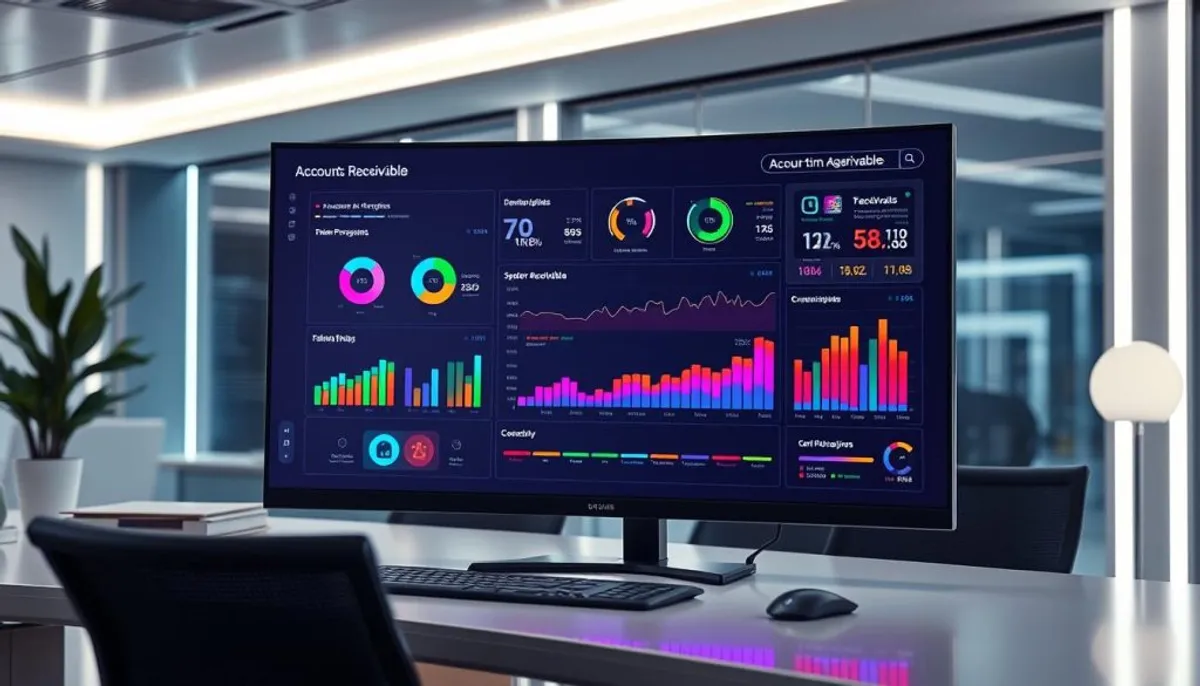In today’s fast-paced business world, accounts receivable technologies are revolutionizing how companies manage their cash flow. AR automation is no longer a luxury but a necessity for businesses aiming to stay competitive and efficient. By implementing cutting-edge AR solutions, companies can significantly enhance their financial operations and optimize cash flow.
Modern AR technologies offer a range of benefits, from reducing manual errors to providing real-time insights into financial health. These tools streamline every step of the receivable process, from invoice generation to payment collection, ensuring a smooth and efficient workflow.

With the right AR automation in place, businesses can expect to see remarkable improvements in their financial processes. For instance, 87% of companies using AR automation report faster overall process speeds. This efficiency translates to quicker payments, with most Stripe invoices settled in less than three days.
The impact of AR technologies extends beyond just speed. They also enhance customer experiences, with 75% of businesses noting improved customer satisfaction after implementing automation tools. This customer-centric approach is crucial in today’s competitive market landscape.
Key Takeaways
- AR automation streamlines the entire receivable process
- 87% of businesses report faster processes with AR automation
- 75% of companies see improved customer experiences
- Most Stripe invoices are settled within three days
- AR technologies optimize cash flow management
- Automation reduces manual errors and increases efficiency
Understanding Modern Accounts Receivable Technologies
Accounts receivable (AR) technologies have transformed financial management in businesses. These innovations automate invoicing, enhance credit management, and integrate with accounting systems seamlessly. The evolution of AR technology has been swift, converting manual processes into efficient digital systems.
Definition and Core Components
AR technologies comprise a set of digital tools aimed at optimizing the receivables process. Key components include automated invoice generation, electronic distribution systems, and advanced payment processing platforms. These elements form a cohesive system that accelerates cash flow and minimizes errors.
Evolution of AR Technology
The evolution of AR technology has seen significant advancements. It has transitioned from paper-based systems to cloud-based solutions, marking a dramatic shift. Modern AR platforms now incorporate artificial intelligence and machine learning, providing predictive analytics and intelligent automation.
Impact on Business Operations
The integration of AR technologies profoundly impacts business operations. Studies indicate that AI-driven automation in accounts receivable can significantly reduce staff workload and processing errors. Digital invoicing and e-payment solutions expedite cash flow by shortening the time between invoicing and payment receipt.
| Impact Area | Before AR Tech | After AR Tech |
|---|---|---|
| Invoice Processing Time | 5-7 days | 1-2 days |
| Payment Receipt | 30+ days | 15-20 days |
| Error Rate | 5-10% | Less than 1% |
| Staff Productivity | 60% on manual tasks | 80% on strategic tasks |
By adopting these technologies, businesses can overcome challenges like late payments, which force 50,000 businesses to cease trading annually. With enhanced efficiency and accuracy, companies can redirect their focus towards growth and customer relationships, rather than solely on payment collection.
The Fundamentals of AR Process Automation
AR process automation is transforming financial management for businesses. It streamlines operations, enhances efficiency, and optimizes cash flow. Let’s explore the essential components that make AR automation indispensable for contemporary enterprises.
Invoice Generation and Distribution
Automated invoicing systems expedite the creation and dispatch of bills with precision. This innovation minimizes errors and accelerates payment cycles. By automating invoicing, companies can produce and disseminate invoices en masse electronically. This approach conserves time and guarantees that clients receive their invoices without delay.
Payment Processing Systems
Modern payment processing systems are crucial for effective AR management. They support a variety of payment modalities, from credit cards to digital wallets. These systems integrate flawlessly with collections software, facilitating the tracking and reconciliation of payments. Rapid and secure payment processing results in expedited settlements, with most invoices settled within three days.
Reconciliation Automation
Automated reconciliation is a transformative tool for finance teams. It automates the matching of incoming payments with outstanding invoices, obviating the need for manual data entry. This process significantly reduces errors by 87% and accelerates the AR cycle. With automation, businesses can expedite their financial close and gain immediate insights into their financial standing.
Adopting these AR automation fundamentals can profoundly enhance a company’s financial operations. Businesses leveraging high levels of automation experience a 23-day reduction in payment receipt times compared to those with minimal or no automation. This increased efficiency not only bolsters cash flow but also strengthens customer relationships, paving the way for sustainable growth.
Benefits of Implementing AR Technologies
AR technologies introduce substantial benefits to enterprises. Firms leveraging these tools witness notable enhancements in their financial operations. For example, entities automating more than half of their AR processes observe a 32% diminution in days sales outstanding (DSO). This facilitates cash flow optimization, enabling quicker access to capital.
Efficiency gains are another pivotal advantage. AR automation streamlines processes, reducing both time and expenses by minimizing manual intervention. It empowers AR analysts to concentrate on strategic endeavors, enhancing overall productivity. Automation can potentially save around 25,000 hours of avoidable rework in finance operations.
Error diminution stands as a critical benefit of AR technologies. CFOs report a 63% decline in billing inaccuracies due to automation. Such precision not only fortifies customer relationships but also ensures adherence to financial regulations.
| Benefit | Impact |
|---|---|
| DSO Reduction | 32% decrease |
| Billing Errors | 63% reduction |
| Time Saved | 25,000 hours |
| Cost Savings | Up to 70% in invoicing |
Real-world instances illustrate these advantages. JobGet optimized its receivables with Centime, reducing overdue invoices and boosting cash flows. GitLab, on the other hand, scaled its workforce from 6 to 11 agents and reduced billing task time by 30% through AR automation.
Key Features of Modern AR Platforms
Modern accounts receivable platforms introduce a suite of advanced features to streamline financial operations. These tools aim to boost efficiency, precision, and transparency in AR processes.
Integration Capabilities
ERP integration stands as a fundamental aspect of contemporary AR platforms. They integrate seamlessly with existing accounting software, forming a cohesive financial environment. This integration ensures data coherence across systems, obviating the need for manual data entry and reducing errors.
Real-time Analytics Dashboard
Reporting analytics are the core of AR platforms. Real-time dashboards provide immediate access to critical metrics such as DSO, collection rates, and aging reports. These visual tools empower finance teams to make informed decisions swiftly.

Customizable Workflow Options
Workflow customization empowers businesses to mold AR processes to their specific requirements. From invoice creation to payment reminders, each phase can be automated and tailored. This adaptability ensures the AR platform aligns with the company’s operations, enhancing efficiency.
| Feature | Benefit |
|---|---|
| ERP Integration | Unified financial data, reduced errors |
| Real-time Analytics | Instant insights, faster decision-making |
| Customizable Workflows | Tailored processes, improved efficiency |
By harnessing these pivotal features, enterprises can revolutionize their AR operations. This transformation leads to expedited payments, enhanced cash flow, and fortified customer relationships.
Cloud-Based AR Solutions
Cloud-based solutions are transforming accounts receivable (AR) management. These scalable AR systems bring unparalleled flexibility and efficiency to financial transactions. They empower businesses to handle their AR processes with greater agility.
Accessibility and Scalability
Cloud-based AR solutions grant access to financial data from anywhere, at any time. This feature allows businesses to manage their AR processes remotely, enhancing operational agility. Scalable AR systems adapt to your business’s growth, eliminating the need for significant infrastructure investments.
Security Measures
Data security is crucial in AR management. Cloud-based platforms employ robust encryption and multi-factor authentication to safeguard sensitive financial information. Regular updates ensure that security measures evolve to counter emerging threats.
Cost-Effectiveness
Cloud-based AR solutions offer substantial cost savings over on-premise systems. They eliminate the need for expensive hardware and reduce IT maintenance costs. Research by McKinsey and Company indicates that cloud adoption can boost technology infrastructure ROI by 29%.
| Feature | Benefit |
|---|---|
| Remote Access | Improved operational flexibility |
| Scalability | Accommodates business growth |
| Enhanced Security | Protects sensitive financial data |
| Cost Reduction | Lower IT and infrastructure expenses |
By adopting cloud-based AR solutions, businesses can streamline their financial processes. They improve data accuracy and focus on core business activities rather than IT management.
Artificial Intelligence in AR Management
AI is transforming accounts receivable management, a field that has seen significant advancements since its inception in 1956. Today, AI-driven insights are revolutionizing how businesses manage their receivables. This transformation brings unprecedented efficiency and accuracy to financial processes.
Modern AR systems rely on machine learning algorithms to analyze vast amounts of data. These algorithms predict payment patterns and identify potential risks. This predictive analytics capability enables companies to proactively manage their cash flow and minimize days sales outstanding (DSO).
AI’s influence on AR management is profound:
- Automated invoice matching and payment processing
- Real-time monitoring of financial health
- Optimized credit decisions and fraud detection
- Streamlined transaction processing
- Improved cash flow forecasting
Tools like Credit-IQ utilize AI to offer real-time insights and automate mundane tasks. This automation not only diminishes errors but also empowers staff to concentrate on strategic endeavors. With AI, businesses can expedite payment processing, enhance customer interactions, and maintain regulatory adherence.
The trajectory of AR management is inextricably linked with AI integration. As these technologies advance, they promise to augment human capabilities, leading to enhanced efficiencies in financial operations.
Streamlining Collections with ti3 Platform
The ti3 platform is a game-changer for accounts receivable management. It’s a SaaS solution designed to tackle overdue payments head-on. This approach boosts cash flow for businesses of all sizes.
Automated Payment Reminders
Ti3’s automated reminders transform the collection process. They significantly reduce manual work, lowering invoice processing costs from $12-$20 per invoice to just $1. The system sends timely, personalized reminders, leading to an 800% increase in on-time payments.
Escalation Management
When gentle nudges are insufficient, ti3’s escalation management takes over. It smartly handles tough cases, reducing the 33% of SMEs waiting over two months for payments. The platform’s approach cuts collection time from weeks to days.
Client Relationship Preservation
Ti3 balances efficient collections with the preservation of positive client relationships. Its friendly, professional tone maintains goodwill while resolving overdue accounts. This approach addresses the 90% of businesses reporting negative impacts from late payments.
| Feature | Impact |
|---|---|
| Automated Reminders | 800% increase in on-time payments |
| Escalation Management | Reduces collection time from weeks to days |
| Client Relationship Focus | Maintains positive relationships while resolving 90% of late payment issues |
By leveraging ti3, businesses can transform their AR processes. This ensures timely payments and preserves valuable client relationships. The platform offers a cost-effective solution to traditional collection methods, streamlining operations and boosting financial health.
Payment Processing and Integration

Modern accounts receivable technologies are transforming payment processing. These systems accommodate various payment methods and integrate smoothly with current financial systems. For businesses operating globally, multi-currency support ensures accurate invoicing across borders.
Integrated payment systems streamline collections, reducing delays and enhancing cash flow. Real-time reconciliation matches incoming payments to invoices instantly, improving accuracy and visibility. This automation minimizes errors, ensuring precise calculations and error-free invoices.
Online payment portals enable customers to pay invoices 24/7, facilitating faster processing. These portals support diverse payment methods:
- ACH transfers
- Wire transfers
- Credit cards
- Electronic funds transfers (EFT)
Flexibility is paramount. Many systems offer auto-pay, partial payments, and “promise to pay” options. This adaptability improves customer experience and loyalty while updating payment terms workflows.
Integration capabilities extend beyond payment processing. Advanced AR platforms connect with multiple financial systems, including:
- ERP systems
- Accounting software
- CRMs
- Banks
This comprehensive integration ensures real-time, accurate financial records and provides a holistic view of operations. It’s a game-changer for businesses seeking to optimize their invoice-to-cash lifecycle and make data-driven decisions.
Data Analytics and Reporting Capabilities
AR analytics have transformed the management of accounts receivable for businesses. Modern platforms now offer sophisticated tools for monitoring performance metrics and generating detailed reports. These tools empower finance teams to base their decisions on data, thus optimizing cash flow.
Performance Metrics
Contemporary AR systems continuously track essential performance indicators. Metrics such as Days Sales Outstanding (DSO) and Accounts Receivable Turnover Ratio are pivotal in assessing collection efficiency. The Collection Effectiveness Index further evaluates the effectiveness of customer collections. By monitoring these metrics, businesses can discern trends and pinpoint areas for enhancement.
Forecasting Tools
Accurate cash flow forecasting is indispensable for financial planning. AR platforms employ historical data and predictive models to forecast future cash inflows. This capability enables companies to anticipate potential cash deficits and devise strategies to mitigate them. Precise forecasts facilitate proactive decision-making and efficient resource allocation.
Custom Report Generation
Customizable reporting is vital for diverse stakeholders. AR systems empower users to craft bespoke reports with pertinent data. Finance teams can produce in-depth analyses for internal use, while executives receive concise summaries. This adaptability enhances communication and supports strategic planning throughout the organization.
| Feature | Benefit |
|---|---|
| Real-time dashboards | Instant visibility into AR performance |
| Predictive analytics | Improved cash flow forecasting |
| Customizable reports | Tailored insights for different stakeholders |
By harnessing these advanced analytics and reporting functionalities, businesses can streamline their AR processes, diminish bad debt, and make informed financial choices. The insights derived from these tools are invaluable for optimizing working capital and fostering growth.
Best Practices for AR Technology Implementation
Implementing AR automation successfully demands meticulous planning. Begin by evaluating your current processes to pinpoint areas for enhancement. Opt for a solution that resonates with your business objectives and integrates harmoniously with your existing infrastructure. Tailoring the solution to your specific needs is paramount.
Training your staff is essential for effective change management. Offer thorough training to ensure a seamless transition. Adopting a phased rollout can facilitate a smoother adaptation process. It is also imperative to establish robust security measures to safeguard sensitive financial information.
Consider these statistics:
- 70% of digital transformation projects fail, according to a Deloitte study
- Over half of participants in a BlackLine webinar reported difficulties updating their systems
- The AR Automation market is projected to grow at a 10.8% CAGR from 2023 to 2033
Despite the hurdles, the benefits of successful AR automation implementation are substantial. It accelerates payment processing, ensures clean ledgers, and boosts working capital. Organizations gain comprehensive insights into previously obscure metrics. Accounting teams can manage data more uniformly, leading to precise financial projections and a reduction in time spent on payment recovery.
AR automation also enhances customer satisfaction by accurately tracking payments. It enables targeted sales efforts and supports informed treasury decisions. Adhering to these best practices can streamline your AR processes and propel your business forward.
Future Trends in AR Technologies
The realm of accounts receivable is undergoing a transformative shift. New technologies are redefining the AR process management landscape. Let’s dive into some groundbreaking trends poised to revolutionize the AR sector.
Blockchain Integration
Blockchain technology is increasingly being adopted in AR. It significantly enhances security and facilitates better payment tracking. This advancement diminishes fraud risks and boosts transaction transparency. Companies leveraging blockchain witness expedited, more secure payment transactions.
Machine Learning Advancements
Machine learning is transforming AR management. It empowers predictive analytics, enabling more accurate payment behavior forecasting. This leads to enhanced cash flow management and a decrease in bad debt. AI-driven tools streamline invoice processing, reminders, and reconciliation, significantly boosting operational efficiency.
Mobile-First Solutions
Mobile AR solutions are gaining momentum. They enable customers to make payments via smartphones, aligning with the increasing demand for mobile transactions. This trend enhances customer satisfaction and accelerates payment cycles.
| Trend | Impact | Adoption Rate |
|---|---|---|
| Blockchain in AR | Enhanced security, reduced fraud | Growing |
| Machine Learning | Improved predictive analytics | Rapid |
| Mobile AR Solutions | Faster payments, better customer experience | High |
These emerging trends are reshaping the AR technology landscape. Businesses embracing these innovations are witnessing enhanced efficiency, improved cash flow, and stronger customer ties. As we progress, the integration of these technologies will become indispensable for maintaining competitiveness in the evolving AR environment.
Conclusion
AR technology has transformed financial process optimization, leading to unprecedented business growth. In 2024, midsize organizations leverage over 112 SaaS applications, underscoring technology’s critical role in modern operations. The shift to electronic invoicing alone can save teams up to 60 hours weekly, illustrating the vast potential for efficiency.
Implementing automated AR systems enables companies to quickly address disputes and streamline the order-to-cash cycle. This significantly boosts business liquidity. The integration of artificial intelligence and machine learning further enhances these benefits. They analyze payment data to optimize processes and predict payment delays. This technological advancement not only accelerates payment collection but also improves cash flow management.
Looking ahead, the significance of AR technologies in enhancing financial performance and reducing risk is paramount. Cloud-based accounting software allows for real-time tracking of invoices and payments. Advanced analytics tools provide essential insights into key performance indicators. By embracing these innovations, businesses can secure sustainable growth in a competitive landscape. They ensure they remain leaders in financial process optimization.
RelatedRelated articles



